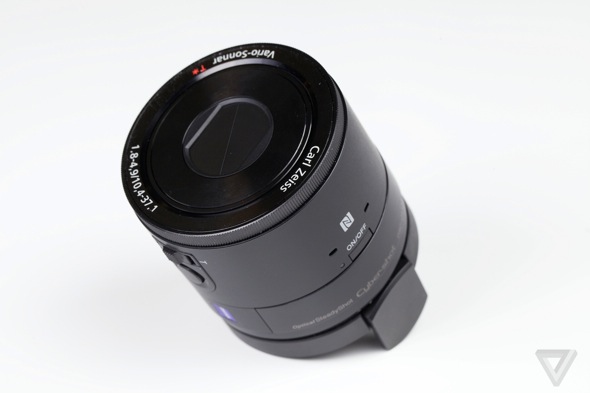Ready, aim
The QX10 and QX100 are more than they seem. These matte black plastic cylinders aren’t just lenses, extensions of the round hole on the back of your smartphone; they’re cameras. Slot a microSD card into either the QX10 or the QX100, and you don’t technically need your smartphone at all — the only thing these full-fledged point-and-shoot cameras are missing is a viewfinder.
ONE PART REAL CAMERA, TWO PARTS SMARTPHONE ACCESSORY

The QX10 is the smaller of the duo, 2.5 inches in diameter and a little more than an inch tall — at about 6 ounces fully loaded, it drops perfectly into a jacket pocket. The QX100 is about twice as tall and a couple of ounces heavier, but in some ways it’s actually easier to use. My fingers often curled around the front of the QX10, and would occasionally get in the way of my shot, but the QX100 could fit my entire hand comfortably. Both devices are sturdy and durable, capable of surviving their share of dings and drops.
Both cameras are fully self-sufficient — just point the lens at your subject, zoom in and out with the switch on the left side, press the shutter right next to it, and you’re done. There’s even a tripod mount, if you need it, though if you’re already carrying a tripod saving space is clearly not your greatest concern.
Shooting with just the lens is completely impractical. You can’t see what you’re shooting, and like with Google Glass I found I took a lot of photos in which my subjects appeared to have no heads or where the landscape was horribly slanted. It just feels weird, too, like you’re holding out a futuristic weapon that will engulf your subject and trap them in its tiny body.
But clamp the lens to the back of your smartphone with two teeth on the included detachable mount, and it starts to feel a bit more comfortable. With one hand on the right side of my phone and the other underneath the lens, my Moto X felt like a DSLR in my hands. The clamp worked with every phone I tried, from the Galaxy Mega down to the iPhone 4S, though they’re both most comfortable on a phone about the size of the HTC One.

I don’t have time to wait this long for my camera
The physical connection isn’t what really matters, though — it’s all about the software. When you use the lenses in conjunction with Sony’s PlayMemories Mobile app, your phone becomes the viewfinder, hard drive, and remote control for a much better camera than you’ve ever had on your smartphone.
There are two ways to connect the QX lenses to your phone. The easy way is NFC: on any phone that supports it, just tapping handset to lens will automatically connect the two devices. If you already have the PlayMemories Mobile app downloaded, it launches ready to shoot; if you haven’t downloaded it, you’re sent straight to the store to get it. The hard way, for any phone without NFC (notably the iPhone), is Wi-Fi — go into settings, connect arduously to the lens’s ad-hoc Wi-Fi network with an awkward alphanumeric password, then open PlayMemories Mobile and see if it took. It’s this kind of clunky process, and the very same PlayMemories Mobile app, that makes Sony’s Wi-Fi-enabled cameras hard to use. You’re not gaining much by using a supposedly more phone-friendly device here — connecting the QX100 isn’t much different from the RX100, or the NEX-6.
Either way, the process isn’t quick. It’s often 5 seconds, or even 10, before the app is open, connected, synced to the camera, and ready to take a picture. That, plus the 10 seconds it takes to clip the QX lens onto your phone in the first place, and the two or three you have to wait for every photo to transfer over Wi-Fi from lens to smartphone (more if you opt to transfer the full file instead of a 2-megapixel version), makes for a soul-crushingly slow experience. More importantly, it makes for a lot of missed shots: I wound up conspicuously following Rudd for about four blocks trying to get the Wi-Fi password right on my iPhone, and I missed Giamatti entirely. So much of a smartphone’s advantage is its speed and convenience, and Sony’s lenses undo that in really frustrating ways.
Of course, time isn’t always of the essence, and if you’re willing to do the work the QX lenses will provide you with pictures the likes of which you’ve never seen from a smartphone.
A camera for your cameraphone: Sony Cyber-shot QX10 and...
No comments:
Post a Comment